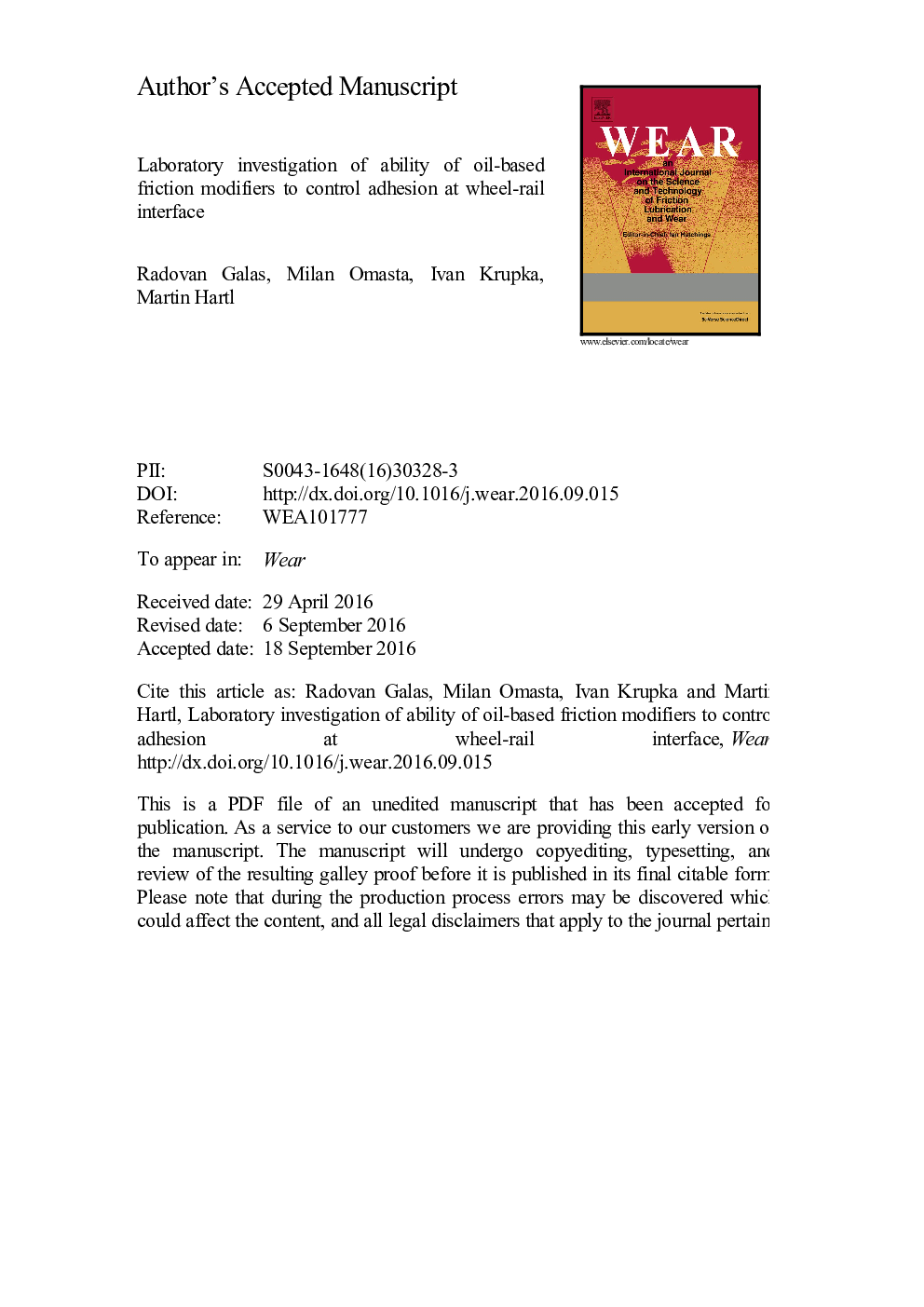| کد مقاله | کد نشریه | سال انتشار | مقاله انگلیسی | نسخه تمام متن |
|---|---|---|---|---|
| 4986899 | 1454957 | 2016 | 36 صفحه PDF | دانلود رایگان |
عنوان انگلیسی مقاله ISI
Laboratory investigation of ability of oil-based friction modifiers to control adhesion at wheel-rail interface
ترجمه فارسی عنوان
بررسی آزمایشگاهی توانایی اصلاح کننده اصطکاک روغن بر کنترل چسبندگی در رابط چرخ-ریل
دانلود مقاله + سفارش ترجمه
دانلود مقاله ISI انگلیسی
رایگان برای ایرانیان
کلمات کلیدی
ضریب پذیرش، اصلاح کننده اصطکاک، تریبولوژی ریلدو، چسبندگی چرخدار
ترجمه چکیده
در چند سال گذشته، اصلاح کننده های اصطکاک بالای خط طراحی شده و مورد استفاده در بسیاری از سیستم های راه آهن در سراسر جهان است. این تقویت کننده های چسبندگی با استفاده از سیستم خارج از هیئت مدیره یا سیستم های برقی به منظور دستیابی به سطح متوسط اصطکاک و منحنی چسبندگی مثبت اعمال می شود. تلاش های قبلی علمی عمدتا بر اثرات اصلاح کننده اصطکاک آب بر روی چسبندگی، خستگی نورد نورد، سر و صدای راه آهن و شکل گیری ریخته گری متمرکز بود. هدف از این مطالعه بررسی توانایی های اصلاح کننده اصطکاک روغن بر روی کنترل چسبندگی و کاهش سایش در رابط چرخ فلزی است. برای این منظور، دو اصلاح کننده اصطکاک تجاری مبتنی بر روغن به طور خاص استفاده شد. یک تری مترمربع توپ بر روی دیسک برای بررسی عملکرد کشش و عملکرد ترمز برای نسبت های مختلف لغزش در شرایط خشک استفاده شد. علاوه بر این، اثر تعدیل کننده اصطکاک بررسی شده است. در پایان آزمایشات انجام شده، میزان سایش، آسیب سطحی و تغییرات توپوگرافی سطح تعیین شده و در مقایسه با تماس خشک و روغن آلوده مقایسه شد. نتایج نشان می دهد که اصلاح کننده های اصطکائی بر پایه روغن قادر به کنترل چسبندگی در تماس چرخان می باشند اما به شدت وابسته به مقدار کاربرد اصلاح کننده اصطکاک می باشد. با توجه به رفتار اصطکاکی و پوشیدن، محتوای ذرات فلزی به نظر می رسد پارامتر حیاتی است.
موضوعات مرتبط
مهندسی و علوم پایه
مهندسی شیمی
شیمی کلوئیدی و سطحی
چکیده انگلیسی
In the last few years, top-of-rail friction modifiers have been designed and used in many railway systems all over the world. These adhesion enhancers are applied by either off-board or on-board system in order to achieve the intermediate level of friction and positive adhesion curve. Previous scientific effort was mainly focused on the effects of water-based friction modifier on adhesion, rolling contact fatigue, railway noise and corrugation formation. The objective of this study is to investigate the abilities of oil-based friction modifiers to control adhesion and reduce wear at wheel rail interface. For this purpose, two commercial oil-based friction modifiers were particularly utilised. A ball-on-disc tribometer was employed to investigate their traction and braking performance for various slip ratios under dry conditions. Furthermore, the effect of friction modifier amount has been studied. At the end of the performed tests, wear rate, surface damage and changes of surface topography were determined and compared to dry and oil-contaminated contact. The results indicate that oil-based friction modifiers are able to control adhesion in wheel-rail contact but it is strongly dependent on the applied amount of friction modifiers. Regarding to the friction behaviour and wear, the content of metal particles seems to be the crucial parameter.
ناشر
Database: Elsevier - ScienceDirect (ساینس دایرکت)
Journal: Wear - Volumes 368â369, 15 December 2016, Pages 230-238
Journal: Wear - Volumes 368â369, 15 December 2016, Pages 230-238
نویسندگان
Radovan Galas, Milan Omasta, Ivan Krupka, Martin Hartl,
